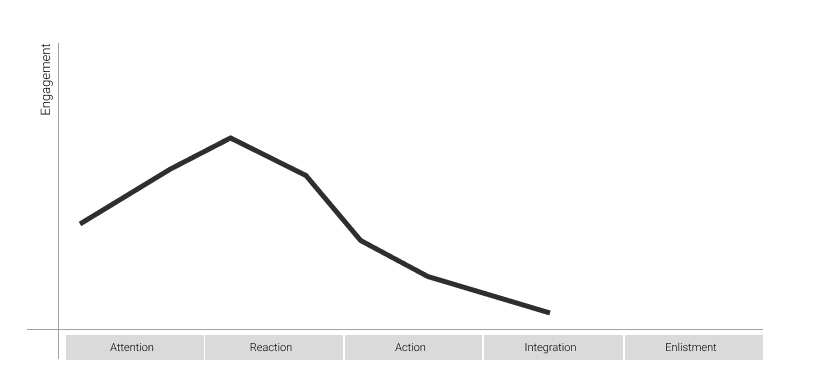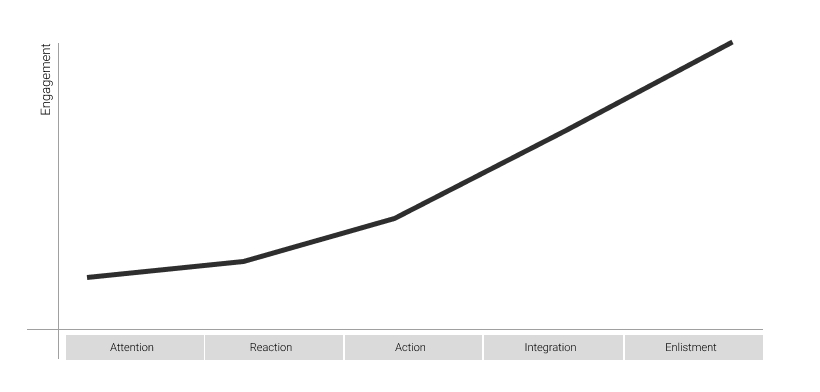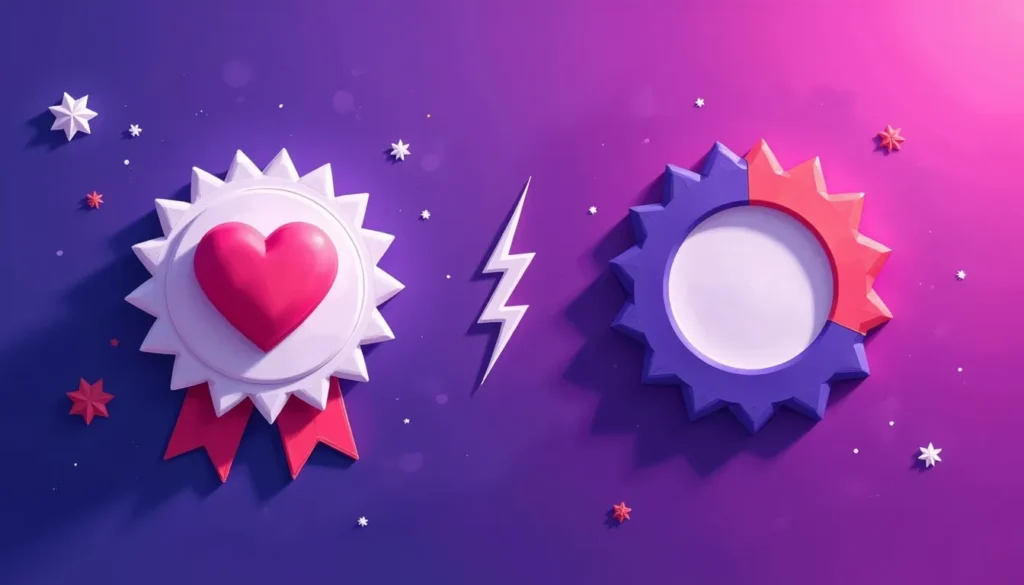Loyalty programs are like sand on the sea. There are just so many of it.
You can collect stickers at the bakery – buy 10, get one for free.
You can get points at the supermarket next door – 100 points nets you a discount on the newest cutlery from WMF.
You can earn miles for flying with Miles&More or driving with MoveOn – and get a coffee voucher at the nearest gas station.
Unfortunately, all these rewards are not very attractive.
The problem these loyalty programs face is: Most of them are incredibly boring – and therefore don’t work very well. In this article, I will explain the problems of typical loyalty programmes and give some tips on how to improve customer loyalty.
Extrinsic loyalty programs don’t work.
It is tempting to build a customer loyalty program with points.
Not only do most loyalty programs work that way, but also it is relatively easy to reward customers with points for every transaction they make.
Of course, the idea behind that is always the same: If customers get points, that’s added value, and hence customers should be motivated to buy more products and services because they want the points, right? If it only was that simple!
Unfortunately, it’s not. In the US, the average Joe is part of roughly 15 different loyalty programs, but only interacts with a single one of them regularly. How can that be?
To understand that, let’s look at psychology. Points are an extrinsic reward. This leads to short-term, but not very sustainable motivation. In addition, points are often distributed in a linear way – users can calculate how long it takes to collect a certain number of points. That, too, is not particularly motivating. Linear designs usually lead to boredom rather quickly.
A german railroad providers makes up for a good example
The german train company, Deutsche Bahn, also has one of those extrinsic loyalty programs. It is well hidden inside their website and app – the company itself might not be so happy with the program, but this is only a guess.
Their bonus programme works like this:
Every time you purchase a train ticket, one point is added to your loyalty wallet for each and every euro you’ve spent.
For 750 points you can buy a seat reservation in first class, which then will be physically shipped to your address. This can take up to ten days. Wow!
This example reveals two problems of typical loyalty programs.
Problem 1: Linear Reward System
So users know that a seat reservation is 750 points and 1 euro equals 1 points. As a result, it’s then not hard to figure out that, in order to get just a seat reservation, you need to spend 750 euros on train tickets.
Well, that’s alot of money!
Users can therefore calculate in advance how long it will take them to get to a certain reward. For obvious reasons, the rewards offered in loyalty programs are usually rather cheap in terms of their monetary value. Therefore, in a linear design, users find out rather quickly that collecting points is, more often that not, barely worth the hassle.
In short: Linear designs are not particularly motivating.
This is well backed by science: In an experiment with monkeys, for example, scientists installed a button in a cage. When the monkey pressed the button, a sweet liquid came out of a straw. The monkey pushed the button until he was full and then stopped.
In a second experiment, the button only had a certain chance to release the sweet liquid. In this case, the monkey pressed the button again and again – even after it had long been full. No longer the liquid itself, but the winning had become the reward. In other words, the monkey became addicted to gambling.
Similar experiments with birds and rats have confirmed the results.
Of course, humans are fairly similar. Suppose we were offered two options: A blue button that pays 2€. Or a green button where we can win maybe nothing, but maybe 20€… most people would probably choose gambling.
Linear reward systems are much less responsive to our emotional system than non-linear designs. As soon as probability is in play – as soon as there is a chance to win nothing, but also a chance to win a lot – humans and animals alike are emotionally activated.
Loyalty programs can use that behavior to their advantage.
Problem 2: Extrinsic rewards
Extrinsic rewards are those that are brought to us from outside. Like points, money, status or material things. When you try to create loyalty through such extrinsic values, you literally buy loyalty.
But what happens when the reward is lost, gets smaller – or at least doesn’t get bigger? Then, the motivation drops off – this is an inherent characteristic of extrinsic design.
Such loyalty programs, which primarily – or exclusively – offer extrinsic rewards, fall into a trap that they themselves lay out: The customer gets used to the reward.
If new rewards are presented too irregularly, or doesn’t grow in value, the motivation to interact with the program decreases, and consequently so does loyalty.
Why traditional loyalty programs don’t work (anymore)
A major problem with loyalty programmes is that it is difficult to measure their success. If customers are more loyal to the program as a whole – does this result from the program, or are loyal customers more likely to join loyalty programs in the first place? It is very possible that most statistics on the loyalty effect contain systematic errors.
Fortunately, psychology can also be used to illustrate the low impact of traditional loyalty programs – but the result is sobering.
With extrinsic, linear loyalty programmes such as the railroad company one mentioned above, the engagement of users looks something like this.

Engagement on linear, extrinsic loyalty programs
Lets look at what happens here
The engagement, shown on the vertical axis, starts relatively well.
A potential customer hears about the program (Attention) and looks at the rewards that can be earned. All those great things! All you have to do is earn a few points and you can buy these extrinsic rewards!
Take the example of the railroad program:
Users see the extrinsic reward of the 1st class reservation and think to themselves: I just have to keep buying train tickets, earn points along the way and then I will be able to get those rewards. Basically for free. Isn’t that great? The engagement is high. But only for a rather short time.
Because then users realize that it takes a very long time until they collect enough points for a reward (action). They start to calculate: 750 points for a reward worth only a few Euros? Phew! The engagement decreases.
From the company’s point of view, it’s best if customers then forget about the program (integration). Worse is when they get frustrated.
So the engagement starts well and then drops off quite quickly. As soon as the customer realizes that the extrinsic rewards have to be bought at a high price, and that the way to get to those rewards is predictable (linear) long, the motivation decreases, and with it the loyalty as well.
What happens here is the exact opposite of what the loyalty program should actually achieve. It does not increase engagement. It does not increase loyalty. It gradually destroys it. The loyalty programme damages the business.
Modern loyalty programmes generate engagement
Compare the graph above with this one.

Engagement on non-linear, intrinsic loyalty programs
This is what the engagement curve of a loyalty program should actually look like. It should increase consistently. The climb does not have to be particularly steep at the beginning – loyalty programmes work best when they are not only extrinsic but also intrinsic, and intrinsic motivations take time.
Points, material goods, status – all these are things that are well suited to get customers into a programme relatively quickly. To increase their initial motivation to join the program.
But if the loyalty program has nothing more to offer than these extrinsic things, it quickly becomes boring. Probably everyone has already registered for a loyalty program that worked extrinsically and linearly and then relatively quickly lost interest in it.
The key is: Intrinsic, non-linear experience
Modern loyalty programs go beyond linear points and extrinsic rewards.
Instead, they focus on intrinsic, non-linear user experiences. There are many possibilities to achieve this.
One of them is the use of a community. It is astonishing how many loyalty programs completely disregard the fact that they have a community of sometimes many thousands of (hardly active) users.
For example, some loyalty programmes also turn their customers into active participants – in such a way that they can participate in new products, test new products, give feedback or be treated particularly well in the event of a problem.
These are the things that generate real loyalty. When you hear people talk about the brands they love, they never say, „Because that’s where I get points for my purchase“.
That doesn’t mean that points are bad per se. But if the loyalty program only consists of points, it won’t work.
Points and extrinsic rewards are very helpful tools for loyalty programs, but they have to be paired with intrinsic rewards. Loyalty programs must create wow moments. This works best with non-linear (i.e. surprising) elements that work intrinsically.
